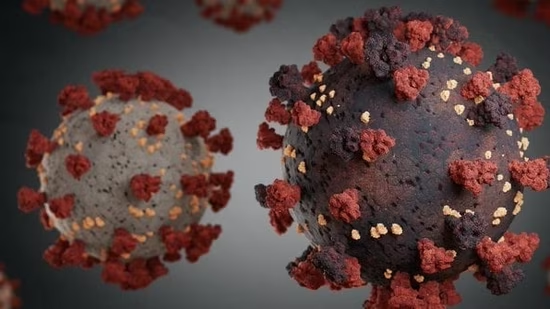All about leading COVID-19 variants HV.1, EG.5 and others spreading wings across US
Four new variants of COVID-19 namely, HV.1, EG.5, BA.2.86 and JN.1 are being tracked by scientists in the US.

EG.5 and HV.1, two closely related variants, currently comprise nearly half of the COVID-19 cases in the US.
Stay tuned with breaking news on HT Channel on Facebook. Join NowEG.5 became the dominant variant in August. At the time, WHO classified it as a “variant of interest,” meaning its genetic changes gave it an advantage and its prevalence within the country was growing. In September, it peaked with about 25% of cases and has now declined to 13% in December.
HV.1 emerged at the end of summer and has made quite a progress to a larger proportion of the spreading virus. As per the CDC, it overtook EG.5 as the dominant variant in late October and now accounts for over 30% of the cases.
The other two variants being tracked by scientists are BA.2.86 and JN.1, which they say are carrying an alarming number of mutations. they together make up the 9% of cases in the US and are on the rise.
Here's all you need to know:
EG.5 & HV.1
According to experts, these two variants don't pose a substantial threat as compared to the other variants that peaked this year.
EG.5 originated in China in February 2023 and was detected in the US in April. It is a descendant of the Omicron variant XBB.1.9.2 and has one notable mutation that helps it to evade antibodies developed by the immune system in response to earlier variants and vaccines.
It does not have any new capacities when it comes to contagiousness and the new vaccines, targeting a related XBB variant, appear to produce enough antibodies to work against it.
HV.1 has descended from EG.5 and is highly similar to it. Given the variants likeness, it’s unclear exactly how HV.1 has overtaken EG.5, but one of the few additional mutations in HV.1 has likely given it an edge over its predecessor.
BA.2.86 & JN.1
BA.2.86 also known as Pirola, is also being closely watched by scientists. This variant worried experts because of the number of mutations it carries in the spike protein, which is what the virus uses to infect human cells and what our immune systems use to identify it.
Adding to the concern, early data indicated that the new vaccines may not be very effective against BA.2.86. However, evidence has since emerged that antibody levels produced in response to BA.2.86 are on par with those developed in response to EG.5, suggesting that the vaccines will be sufficiently protective against it.
JN.1 has recently emerged from BA.2.86 and is spreading quickly. It carries a mutation that gives it extra immune-evading capabilities. The preprint paper testing how the new vaccines performed against HV.1 also showed that they produced antibodies effective against JN.1, but not as many.
More than the risk conferred by any individual variant, it is the rapid rate of virus evolution that is most concerning to Trevor Bedford, a professor in the vaccine and infectious disease division at the Fred Hutchinson Cancer Center. “No single variant has been that impactful,” he said, “but the overall accumulation of these mutations is having significant impact.”
Disclaimer: The copyright of this article belongs to the original author. Reposting this article is solely for the purpose of information dissemination and does not constitute any investment advice. If there is any infringement, please contact us immediately. We will make corrections or deletions as necessary. Thank you.
Title:All about leading COVID-19 variants HV.1, EG.5 and others spreading wings across US
Url:https://www.investsfocus.com







